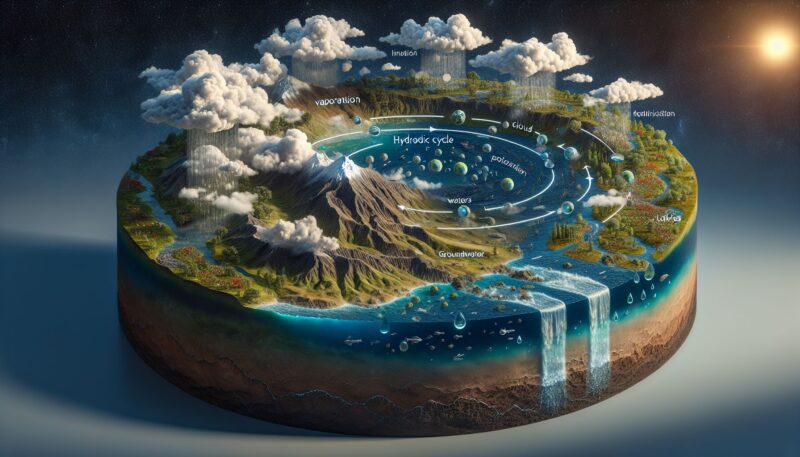Water is the lifeblood of our planet, a precious resource that sustains all forms of life. Central to the existence and continuous supply of this invaluable resource is the hydrologic cycle, also known as the water cycle. It is a complex system that describes the continuous movement of water on, above, and below the surface of the Earth. Understanding this cycle is crucial, not only for scientists and researchers but for every individual, as it directly affects ecosystems, weather patterns, and even socio-economic structures.
What is the Hydrologic Cycle?
The hydrologic cycle is a natural sequence of processes that recycles Earth’s water. It is a closed-loop system that involves the transfer of water from the oceans, through the atmosphere, to the land, and back to the sea. This cycle is driven mainly by the sun’s energy and governed by the laws of physics.
How the Hydrologic Cycle Works
To fully grasp the hydrologic cycle, we must break it down into its key components:
Evaporation
Evaporation is the process by which water is transformed from liquid to vapor. The sun heats water in rivers, lakes, and oceans, causing it to vaporize and ascent into the atmosphere. Plants also contribute to evaporation through a process called transpiration, where they release water vapor from their leaves.
Condensation
Once water vapor rises higher into the atmosphere, it cools down and turns back into liquid droplets through condensation. These tiny droplets cluster around dust particles, forming clouds.
Precipitation
When these droplets combine and grow heavy enough, they fall to the earth’s surface as precipitation, which includes rain, snow, sleet, or hail. Precipitation replenishes water in bodies of freshwater and is critical for terrestrial life.
Infiltration and Percolation
After precipitation, some of the water seeps into the ground, in a process known as infiltration. This water then moves downward through soil and rock, a movement referred to as percolation, eventually reaching groundwater stores such as aquifers.
Runoff and Streamflow
A portion of the precipitation does not infiltrate but instead flows over the land as surface runoff. This runoff eventually gathers into streams and rivers, contributing to streamflow, which carries water back to the oceans.
Groundwater Movement
Some of the infiltrated water becomes groundwater, which moves much more slowly than surface water. Groundwater can return to the surface as a spring or seep into rivers, lakes, and oceans.
Baseflow
Baseflow is the portion of streamflow that is sustained between precipitation events, fed into streams by delayed pathways such as groundwater seeping into the bed of rivers.
Discharge and Recharge
Groundwater is stored in aquifers and can be discharged into rivers and bodies of water through springs or human extraction. Recharge occurs when water from precipitation and runoff percolates into the aquifer.
Sublimation and Deposition
Additionally, there are other, less common, parts of the hydrologic cycle. Sublimation is the process where ice and snow change directly into vapor without first melting into water. Deposition is the opposite, where vapor changes directly into solid ice crystals.
The Importance of the Hydrologic Cycle
The hydrologic cycle plays a critical role in numerous environmental functions and is essential for life on Earth:
- Climate Regulation: The cycle helps regulate the Earth’s temperature and plays a significant role in the weather patterns.
- Water Purification: As water evaporates and then precipitates, it is naturally purified, which benefits both ecosystems and human water use.
- Habitats Formation: The cycle supports the creation and maintenance of various aquatic and terrestrial habitats.
- Nutrient Cycle: Through precipitation and runoff, essential nutrients are transported across landscapes, supporting plant and animal life.
- Human Activities: The cycle is vital for agriculture, hydropower, drinking water supplies, and many other human endeavors.
Human Impact on the Hydrologic Cycle
Human activities have significant impacts on the hydrologic cycle. Climate change, caused by increased greenhouse gas emissions, is altering the cycle by increasing temperatures, changing precipitation patterns, and intensifying extreme weather events. Land use changes, such as deforestation and urbanization, affect infiltration and runoff rates. Pollution and over-extraction of water resources also disrupt this delicate balance.
Conclusion
Understanding the workings of the hydrologic cycle is vital not only for researchers and policy-makers but also for the general public. Our actions can have profound effects on the cycle’s balance, which in turn can feedback to impact our own lives through changes in weather, availability of water resources, and the health of ecosystems.
Sources
For further information and research, the following sources provide valuable insights into the hydrologic cycle and its vital role:
By understanding the hydrologic cycle, we can better predict weather patterns, manage water resources, and protect our environment. It is a continuous reminder of the intricate balance of nature and the interconnectivity of Earth’s systems.
